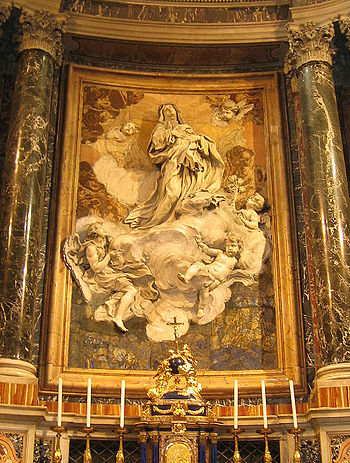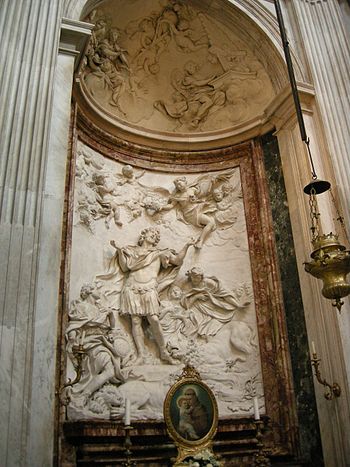- Melchiorre Cafà
-
- This article is about the sculptor Melchiorre Cafà, or Caffa. For other uses of Caffa, see Caffa (disambiguation)
Melchiorre Cafà (in Italy also known as Caffà, in Malta as Gafa, Gafà, Gaffar or Gafar; 1636–1667) [1] was a sculptor from Malta. Cafà began a promising career in Baroque Rome but this was cut short by his premature death following a work accident.
Contents
Biography
He was born Vittoriosa, Malta, and given the name Marcello at his baptism on 21 January 1636. After his move to Rome in 1658 or shortly after, he was most frequently referred to as Melchior (or Melchiorre) Maltese. His brother Lorenzo Gafà was one of the leading architects in Malta.
Cafà was already an accomplished sculptor when he came to Rome and entered the workshop of Ercole Ferrata, who was not strictly speaking his teacher although he probably helped him refining his technique. Despite soon attracting his own commissions, he stayed in close contact with Ferrata and collaborated with him.
In 1660 Cafà signed his first independent contract with Prince Camillo Pamphilj for the relief of the Martyrdom of Saint Eustace in Sant'Agnese in Agone. In 1662 he became a member of the Accademia di San Luca and was even elected its principal in 1667, but declined the honor. Reportedly, he was a close friend of the painter Giovanni Battista Gaulli. Cafà died on the 4 September 1667 after some material collapsed on him in the foundry of Saint Peter's while he was working on the altar decoration[2] for St John's Co-Cathedral in Valletta.
Works
Extremely busy throughout his short life, he only managed to finish a few major commissions himself:
- Wooden statue of Saint Paul in St. Paul's Shipwreck in Valletta (c. 1659).
- Wooden statue of the Virgin of the Rosary in the Dominican Church, Rabat, Malta (1660–61).
- The marble statue of the dying Saint Rose of Lima (signed and dated 1665; Lima, Santo Domingo) was in 1668 the centrepiece for the future saint's Beatification ceremony in Rome's Santa Maria sopra Minerva, and shipped to Peru straight after that event. While it has some formal analogies with Bernini's Ecstasy of St Theresa and possibly influenced in its turn the latter's Death of the Blessed Ludovica Albertoni, Cafà's statue depicts a peaceful death, free from the turmoil in the two works by Bernini.
- Saint Thomas of Villanova distributing alms in the church of Sant'Agostino in Rome (1663–69).
- The relief in white marble of the Ecstasy of Saint Catherine of Siena at Santa Caterina a Magnanapoli in Rome. The curved polychrome background is suggestive of cloud formations and of a halo, intensifying the idea that the saint is carried to heaven. There are no known dates for Cafà's intervention, but it is generally accepted that he finished it himself, i.e. 1667 or earlier.
- A bust of Alexander VII exists in an extremely fine terracotta version in the Palazzo Chigi in Ariccia, a signed bronze (dated 1667) is in New York's Metropolitan Museum (photo here) and a further bronze in the Duomo in Siena.
A number of Cafà terracottas are in the Hermitage Museum in St. Petersburg, the National Museum of Fine Arts in Valletta, the Museo di Palazzo Venezia in Rome and the Museo di Roma. There are various wax reliefs and sculptures by Cafà in Malta: the Valletta Museum has sketches of martyrs, and models for the statues in the colonnade in Saint Peter's Square in Rome. In a private collection there is a wax Glory of St Catherine of Siena, a preparatory study for the marble relief in the church of Santa Caterina a Magnanapoli. And four reliefs were recently discovered in the Cathedral of Mdina representing the Nativity, the Adoration of the shepherds, the Annunciation and the Glory of St. Rose of Lima.[3]
Most unfinished works were completed by Ercole Ferrata, e.g.:
- Martyrdom of Saint Eustace in Sant'Agnese in Agone, Rome (1660–69). Cafà's terracotta is in the Museo di Palazzo Venezia in Rome.
- Saint Thomas of Villanova distributing alms in the church of Sant'Agostino in Rome (1663–69). Cafà's terracotta is in the National Museum of Fine Arts in Valletta.
- Marble statue of Pope Alexander III in the Duomo in Siena (from 1665/66).
- Marble statue of Saint Paul in St. Paul's Grotto, Rabat, Malta (1666–69).
Notes
- ^ After a long period of various spellings, international scholars of Italian baroque sculpture finally agreed on the spelling Cafà, which he himself used when signing works; cf. the book by Sciberras cited below.
- ^ This was eventually executed decades later and after a new design by Cafà's most distinguished (and according to contemporary sources his only) pupil Giuseppe Mazzuoli.
- ^ George Cini (1 December 2010). "Four wax reliefs by Melchiorre Cafà discovered in Mdina". Times of Malta. http://www.timesofmalta.com/articles/view/20101201/local/four-wax-reliefs-by-melchiorre-cafa-discovered-in-mdina. Retrieved 5 December 2010.
Sources
- Rudolf Preimesberger, in: Dizionario Biografico degli Italiani, vol. 16, 1973, pp. 230–235 (Italian)
- Gerhard Bissell, in: Allgemeines Künstlerlexikon, vol. 15, 1997, pp. 493–495 (German)
- Keith Sciberras (Ed.), Melchiorre Cafà. Maltese Genius of the Roman Baroque, Valletta 2006 (individual entries in English or Italian)
- Sante Guido, Giuseppe Mantella, Melchiorre Cafà insigne modellatore. La Natività, l'Adorazione dei pastori e altre opere in cera, Soveria Mannelli (CZ) 2010. (Italian)
External links
Categories:- 1636 births
- 1667 deaths
- Maltese sculptors
- Italian sculptors
Wikimedia Foundation. 2010.


